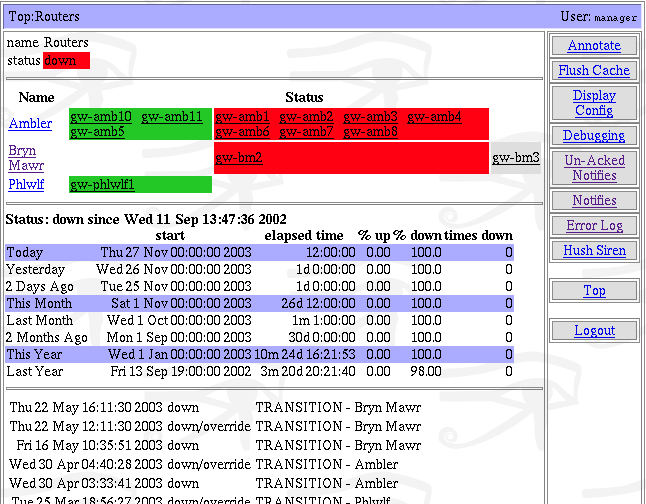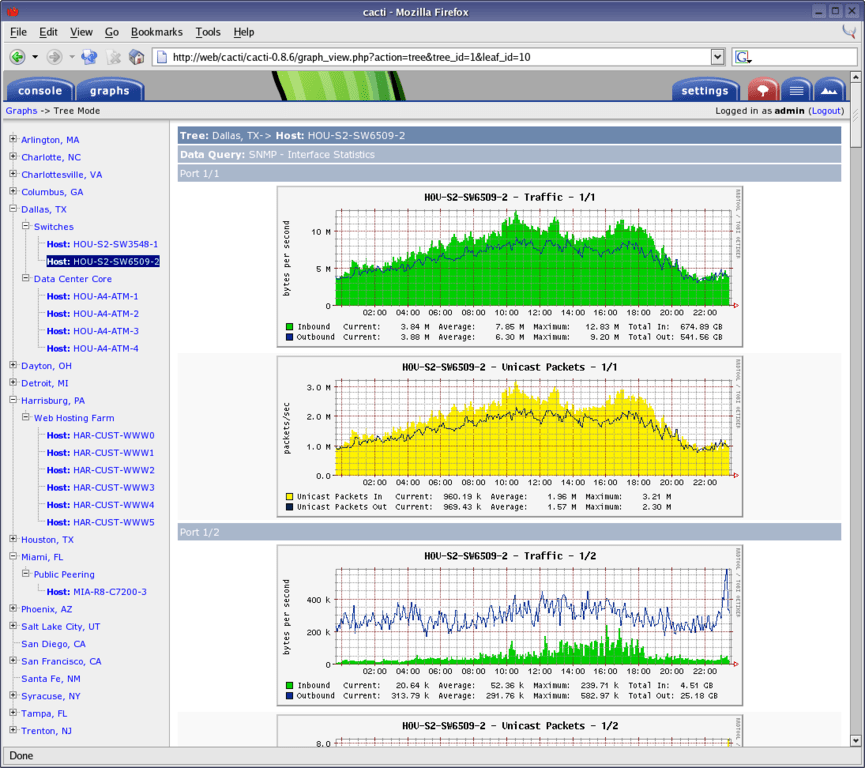The top 11 free server monitoring tools of 2021
Whether we need a web server that connects our users to a database, or a server that collects our documents to print and keeps track of the sheets we spend, monitoring a server simplifies it:
- They are always computers, physically speaking: we must monitor their temperature, state of disks, and so on.
- They are always connected to other computers, so the monitoring of the network, whether public or private, is essential: if you have a connection, if you have services running, how long it takes to receive a file of several megabytes.
- Remember the Interface Message Processors (IMP)? Yes, we need to monitor the routers and/or switches (and even modems) that keep our servers connected, to see if they become “bottlenecks” for your work and performance.
This whole introduction was necessary to be well placed and in context for our list of free server monitoring tools. We present them to you with a brief description and their key or main characteristics. As it is not a comparison, you can evaluate, with your very particular needs, which one is better or more convenient for you.
Pandora FMS
Of course, we had to start by the tool that makes this blog possible. Pandora FMS offers full server monitoring that covers from hardware to applications.
The best way to get to know this tool is… by trying it! And you’re lucky Pandora FMS offers two ways to do it:
- If you have modest monitoring needs, you may try Pandora FMS OpenSource version through the Community version page here.
- If on the contrary you have more demanding monitoring needs and you need to monitor 100 devices or more, you may get a Pandora FMS Enterprise (paid version) FREE 30-day TRIAL. Get it here.
Both of them are amazing tools for server monitoring. Although the Enterprise version offers some very powerful additional features, such as its Metaconsole, that will offer you high scalability to manage dozens of thousands of servers through a single console.
If you want to know how simple and flexible is the monitoring of servers in Pandora FMS you can take a look at this video:
Or if you want to go much deeper into monitoring servers with Pandora FMS you can see the following Workshop:
Argus

Argus
Written entirely in Perl language and not at all in Argus language with a web interface (without API) and for any Unix/Linux server, it is more oriented to network monitoring (remote monitoring), but also includes the monitoring of services and local resources through an agent. It is configured by means of simple text files, which indicates that for a high volume of devices it is not possible to establish policies. Don’t underestimate it: it’s distributed and it’s able to extract data from our own scripts.
Cacti

Cacti
Let’s get back to our list of free server monitoring tools with a champion of graphics with RRDtool and oriented to SNMP monitoring, which marked its origin. We recommend it to monitor game servers where connectivity deprives everything else and in order to monitor the bandwidth. For few devices we have the PHP language, reusing its cmd.php file, but if we grow we will use the C language to use “Spine”, formerly known as Cactid. It uses MySQL for certain functions, but for auditing historical data it won’t work.
Collectd

Collectd
A daemon written in C language about Unix, but it stands out in its modularity, so much so that it has an add-on for RRDtool and can monitor remotely and locally with other add-ons (it can even send data to other demons, i.e. act as a Software Agent). In itself it is so small that it is used together with OpenWRT, an “operating system” for routers and is even used by some computer giants. It is difficult to classify because it handles several free use licenses according to their extensions, which in turn provide different functionalities. Although it is installed on any Unix/Linux, the modules are not written for all the OS’s.
Ganglia
It constitutes a federation by means of gmetad, which is in charge of representing the state of the cluster to send it to other gmetad and/or gmond. Here the term promiscuity is very well represented, since they start from using IP addresses as access control between themselves. We will be able to observe its performance with a web interface written in PHP, and it uses C, Perl and Python language with the help of RRDtool to save data and show graphs. Currently he is no longer part of OpenNebula.
Icinga
Also written in C language, like Collectd, but it’s quite a heavyweight. Son of Nagios, which is characterized by unwittingly encouraging everyone to develop their own solutions, starting with it; Icinga is also part of other software such as GroudWork. We must make it clear that there is Icinga 1, which we must install if we migrate from Nagios and then install Icinga 2. Both have common elements, of course improved, but it creates a sea of confusion to manage. At least the community of users and administrators is very large, and with work we will be able to reuse/adapt code in Nagios. It has add-ons for other operating systems.
Monit
It is promoted as a small tool and claims to be ready and working in 15 minutes; this is due to the fact that it is oriented to monitoring processes, even restarting them if necessary. It interferes with security by promising to track and control the change of files by MD5 and SHA1; keep track of its CPU consumption on the server to be monitored, precisely by means of itself, which also monitors memory usage and workload. It performs basic network tests and the visualization of states can be centralized by command line or one by one by web interface (M/Monit is a separate tool that centralizes web interfaces).
Munin
With over 500 add-ons (300 of which make up the system itself), this work by Jimmy Olsen has stabilised its development. Written in Perl 5.10 and RRDtool for web interface graphics, it has a very dominant master/slave scheme: it only asks the nodes from time to time for new data. Such nodes can use software agents in Perl (even older versions), in Python, for OpenWRT (basic Perl), in Shell scripts, and in the minimal form: inetd/xinetd! This is convenient for our servers with few hardware resources and we will be able to reuse our shell scripts.
Nagios
What more can we say about Nagios? Click for all our articles!
Observium
It is focused on network monitoring and self-discovery of types of devices, platforms and operating systems, it does not complicate our lives with little maintenance and receives updates twice a year. It’s a tool for people who are calm and without hardship. It provides us with both normal and proprietary MIB’s in the case of SNMP, and maintains close relationships with manufacturers to update them. It surprises the integration with Collectd, Munin, Smokeping and RANCID (these last two not analysed here) to monitor Apache, BIND, DRBD, Memcached, MySQL, NFS, among others. It has other paid editions: “Professional” and “Enterprise“.
Zenoss
Made in Python and Java, it supports plug-ins in Nagios format and we can develop our own in Python (ZenPacks, there are already more than 400) with free software license. It has alerts, self-discovery and network changes (SNMP, SSH, WMI) with Twisted and attention to the Net-SNMP protocol; monitoring of network services (HTTP, POP3, NNTP, SNMP, FTP). Web server uses Zope (Python), RRDtool for graphics, uses MySQL
In the world of free software there are many other tools: Performance Co-Pilot, Anturis, SeaLion, SysUsage, Monitor.us or us (Teamviewer), Spiceworks… and the ones you develop!
Finally we did not want to say goodbye without leaving you with this video in which you can see our workshop on server monitoring. It is very complete, almost an hour long, and thanks to it you will be able to understand better how the server monitoring works in Pandora FMS. We hope you like it!

Programmer since 1993 at KS7000.net.ve (since 2014 free software solutions for commercial pharmacies in Venezuela). He writes regularly for Pandora FMS and offers advice on the forum . He is also an enthusiastic contributor to Wikipedia and Wikidata. He crushes iron in gyms and when he can, he also exercises cycling. Science fiction fan. Programmer since 1993 in KS7000.net.ve (since 2014 free software solutions for commercial pharmacies in Venezuela). He writes regularly for Pandora FMS and offers advice in the forum. Also an enthusiastic contributor to Wikipedia and Wikidata. He crusher of irons in gyms and when he can he exercises in cycling as well. Science fiction fan.





















